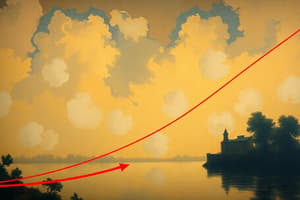Podcast
Questions and Answers
What effect do competitive antagonists have on the dose-response curve of an agonist?
What effect do competitive antagonists have on the dose-response curve of an agonist?
- It shifts the curve to the left.
- It shifts the curve downward.
- It shifts the curve to the right. (correct)
- It alters the maximum effect of the agonist.
Which statement is true regarding non-competitive antagonists?
Which statement is true regarding non-competitive antagonists?
- They compete directly with agonists for binding.
- They affect the maximum effect (Emax) without changing Kd. (correct)
- They increase the affinity of the agonist for the receptor.
- They bind irreversibly to the agonist's active site.
In the double reciprocal plot for competitive antagonists, what happens to the x-axis intersection as the dose of antagonist increases?
In the double reciprocal plot for competitive antagonists, what happens to the x-axis intersection as the dose of antagonist increases?
- It moves closer to Kd.
- It moves closer to zero. (correct)
- It remains constant.
- It shifts further away from zero.
What differentiates a competitive antagonist from a non-competitive antagonist in terms of interaction with agonists?
What differentiates a competitive antagonist from a non-competitive antagonist in terms of interaction with agonists?
When a non-competitive antagonist is introduced, what aspect of the dose-response curve is primarily affected?
When a non-competitive antagonist is introduced, what aspect of the dose-response curve is primarily affected?
What happens to the intersection point in a double reciprocal plot for non-competitive antagonists?
What happens to the intersection point in a double reciprocal plot for non-competitive antagonists?
In the context of competitive antagonism, what happens to the apparent Kd as inhibitor concentration increases?
In the context of competitive antagonism, what happens to the apparent Kd as inhibitor concentration increases?
What is the significance of pA2 in the context of the Schild equation?
What is the significance of pA2 in the context of the Schild equation?
Which statement is true regarding the interaction of non-competitive antagonists with receptors?
Which statement is true regarding the interaction of non-competitive antagonists with receptors?
How is drug potency generally compared between two drugs?
How is drug potency generally compared between two drugs?
What distinguishes efficacy from potency in pharmacology?
What distinguishes efficacy from potency in pharmacology?
What is an important conclusion about drugs with the same potency?
What is an important conclusion about drugs with the same potency?
What is intrinsic activity as it relates to agonists and antagonists?
What is intrinsic activity as it relates to agonists and antagonists?
In what scenario would a competitive antagonist's effects be most pronounced?
In what scenario would a competitive antagonist's effects be most pronounced?
How does the concentration of a competitive antagonist influence its degree of inhibition?
How does the concentration of a competitive antagonist influence its degree of inhibition?
Flashcards are hidden until you start studying
Study Notes
Antagonism
- Competitive antagonists shift agonist dose-response curves to the right; higher agonist doses are needed for the same effect.
- Non-competitive antagonists do not change the affinity of the agonist but decrease the maximum effect (Emax) without affecting Kd.
- Non-competitive antagonists can interact irreversibly at the agonist's binding site or act as allosteric modulators at different binding sites.
Dose-Response Curves
- In double reciprocal plots, competitive antagonists show a shift in intersection with the x-axis, indicating changes in Kd, while y-axis intersection (1/Emax) remains constant.
- Non-competitive antagonists affect the y-axis intersection (1/Emax) and not the x-axis (Kd), indicating no change in affinity.
Competitive Antagonism
- The presence of a competitive antagonist modifies the equilibrium formula for receptor-ligand interactions, leading to an apparent increase in Kd.
- The Schild equation is used to determine if an antagonist is competitive. When the antagonist's concentration is double that of the ligand, pA2 = -log Ki indicates relative affinity.
Non-Competitive Antagonism
- Non-competitive antagonists interact without affecting agonist affinity; hence, IC50 equals Ki.
- The maximum effect decreases, whereas the affinity remains unchanged.
Potency
- Potency defines a drug's effectiveness concerning lower doses needed to achieve the same effect compared to others; measured by Kd or EC50.
- In vitro potency correlates with receptor affinity, but in vivo factors like tolerance and metabolism can alter this relationship.
Efficacy
- Efficacy refers to the maximum response achievable by a drug; high potency does not imply high efficacy.
- Clinical relevance often prioritizes efficacy over potency; effective, less potent drugs may be preferred in therapy.
Intrinsic Activity/Efficacy Theory
- Agonists possess intrinsic activity (α) influencing efficacy;
- Full agonists α = 1,
- Partial agonists 0 < α < 1,
- Inverse agonists α < 0.
- Antagonists have no intrinsic activity (α = 0) and cannot trigger a response.
- Partial agonists can shift curves like competitive antagonists and stabilize inactive receptor states like inverse agonists.
Agonist-Antagonists or Partial Agonists
- Partial agonists display both agonist and antagonist properties; they compete with full agonists at lower effect levels.
- Their intrinsic activity generally falls between 0.2 and 0.3, affecting agonist potency similarly to competitive antagonists.
Studying That Suits You
Use AI to generate personalized quizzes and flashcards to suit your learning preferences.



